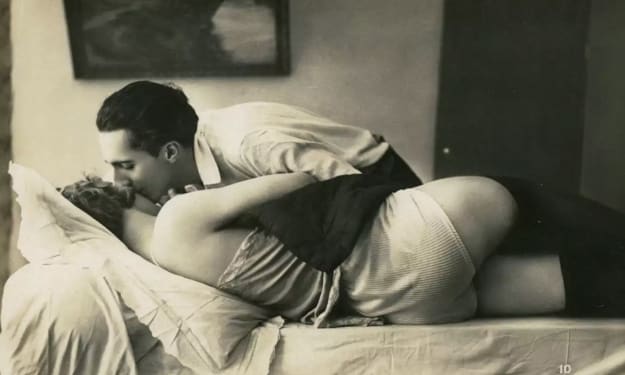Who Was Colette?
Colette's fantasies, nourished in her novels and by her kinkily eroticized imagination, inspired future generations.

I had a friend. She was a writer. As an adolescent and through part of her young adulthood, she could imagine herself as clay, as some moldable stuff to which a man's experienced hands would give shape and value. She would write a paper and a professor would see promise, he would make her his assistant. She would be traveling in the south of France. An artist would notice of her at a café and find something unusual in the shape of her face; He would paint her. Of course there would be sex. She would disregard the baggy eyes and puckered flesh of the older man, being thought of as "special" would suffice as an aphrodisiac. They would make an exchange: He would get youth, she would get experience. And after her apprenticeship affair, she would emerge a writer, an artist on her own.
Her fantasies were nourished by novels and plays, by the kinkily eroticized talk between masters and clever girls in Charlotte Brontë, by characters like Henry Higgins. And, more importantly, by the half earned and half-understood stories she read of actual famous and talented women, women like Colette.
In 1893, at nineteen, Colette married Henri Gauthier-Villars, "Willy" as he was called, and went to live in Paris with this man whom she really did not know at all. He was twice her age, a journalist, a gifted writer with incurable writer's block who signed his name to the books written by a retinue of accomplice ghosts.
Colette's marriage was a disaster. Willy was openly cruelly unfaithful to her from the start. After he discovered that there was marketable literature to be gleaned from his bride, Colette was made to sit alone for hours writing into a copybook. Of course, Willy claimed authorship of the Claudine books which she produced, and of course he collected the enormous profits her novels subsequently earned.
About the fantasies that brought Colette under Willy's scavenger wing about just such fantasies as once fabricated—Colette was later to write: "There are many scarcely nubile girls who dream of becoming the licentious masterpiece of some middle-aged man. It is an ugly dream that is punished by its fulfillment, a morbid thing akin to the neuroses of puberty, the habit of reading dirty books and sticking pins into the palm of the hand."
The above is from My Apprenticeships (written in 1935), translated by Helen Beauclerk, published in the US for the first time (Farrar, Straus and GirOLIX, 510 hard $2.95 paper). My Apprentice ships is a brief, precise, exquisite memoir tale of Colette's relationship with Willy written 30 years after their separation. Time gave Colette perfect clarity. She is not bitter. She describes convincingly the charm and talent that made her husband the successful manipulator that he was. Speaking of her capacity for objectivity, she writes, "Perhaps the mouse, between one blow and the next, has respite enough to appreciate the softness of a cat's paw." What Colette appreciated and never forgot was that, at Willy's urging, she became a writer.
But Willy did not make Colette a writer. Colette did that herself. It was a gradual process, a process not of working under Willy's direction, but rather of freeing herself from his control. My Apprenticeships is the story of Colette's attempts to end her apprenticeship. There is nothing nostalgic, nothing ambivalent about her loathing for her former status. In My Apprenticeships Colette set out to bury the sentimental myth of the contented, thriving female acolyte, and she succeeded.
She succeeded as well in mastering the style and themes that characterize her best works: The Vagabond, The Pure and The Impure, Sido, Chéri, The Last of Chéri, and My Apprenticeships. Colette's genius is for setting, for sensual concreteness, and for psychological realism. Words like "intoxicating" and "seductive" come to mind when one thinks of her prose. The life that goes on in Colette's books becomes part of the reader's daily life, lingering for a long time, affecting vision, understanding, taste—and that is the highest praise I can think to give a writer.
While she was still under Willy's direction, her two short novels about Minnie were first published together in 1909. Minne, the central figure, is a child-woman both inhibited and curious about sex. Minne's ambivalence and immaturity are designed intentionally probably by Willy himself, to arouse the reader whose breath quickens at a mere mention of naked but flat girl-breasts, and dangling feet wearing socks.
The Innocent Libertine bears Willy's thumbprint but there is evident tension here too, an attempt on Colette's part to crack the Minnie type, to humanize and enrich the woman's inner life. Although much of the writing is coy and precious-like the title itself, Colette takes the ephemeral, soft-core characters and plot and transforms them. The Innocent Libertine may be another child/woman-seductress story, but the novelty here is that we see the action through the eyes of the nymph. And that changes everything.
We see that Minne's sexual curiosity is not motivated by rabid lasciviousness or hormones, it is a form of defiance. Minne wants to know what girls have always been forbidden to know about—sex. For Minne, as for many of Colette's sheltered women, sex stands for experience, for adventure, for the important and dramatic event in life. Nothing else appears to be available. And when sex turns out to be a banal disappointment, as it does for Minne, she is furious. "You wait and you wait, and feel as if your whole body wanted to burst into tears and... nothing happens," Minne says. "He steals that pleasure from me!" she says, envious of her husband's easy orgasm. "It's mine, mine—it's I who should be struck by that divine thunderbolt."
Elsewhere in the novel, Minne declares herself on the issue of sexual honesty. "Irene Chaulieu says... that as long as you cry out Ahl Ah! and clench your fists and pretend to choke, that completely satisfies them. Perhaps that satisfies men, but it doesn't satisfy me."
By candidly expressing Minne's sexual feelings, Colette was declaring the same thing about honesty in writing that Minne was professing about honesty in bed. Minne's interior life is so evidently original. Colette's writing is open and unfettered, the first stage of what would eventually develop into the fully mature, entirely direct writing of My Apprenticeships.
But in The Innocent Libertine, Collette was still writing in part to please Willy—or some internalized Willy—and she was the refore "faking" her art. Minne's poutish eroticism and the pat, end-of-book orgasm for Minne furnished by her husband are the unconvincing "clenched fist" and "Ah! Ah" of this novel. As a whole, The Innocent Libertine does not satisfy me, and, as Colette was later to write in a preface, neither this nor any of the books she wrote under Willy's eye satisfied her very much eitherAbout the Creator
Lizzie Boudoir
Thrice married, in love once, overly romantic, and hypersexual.






Comments
There are no comments for this story
Be the first to respond and start the conversation.